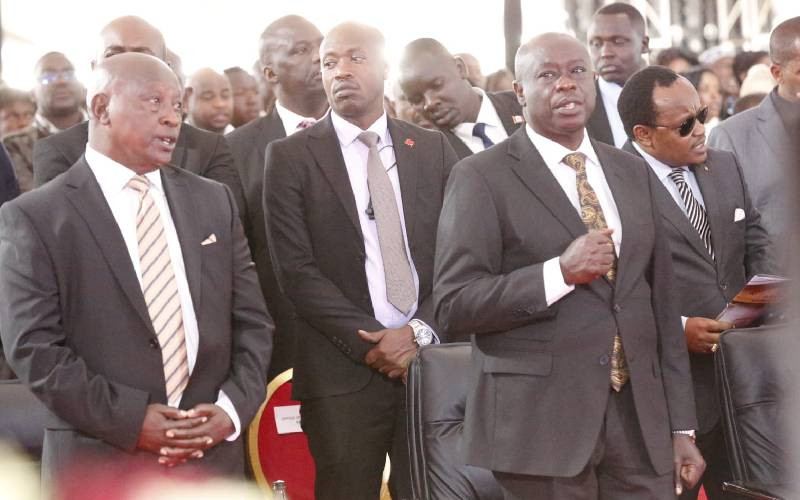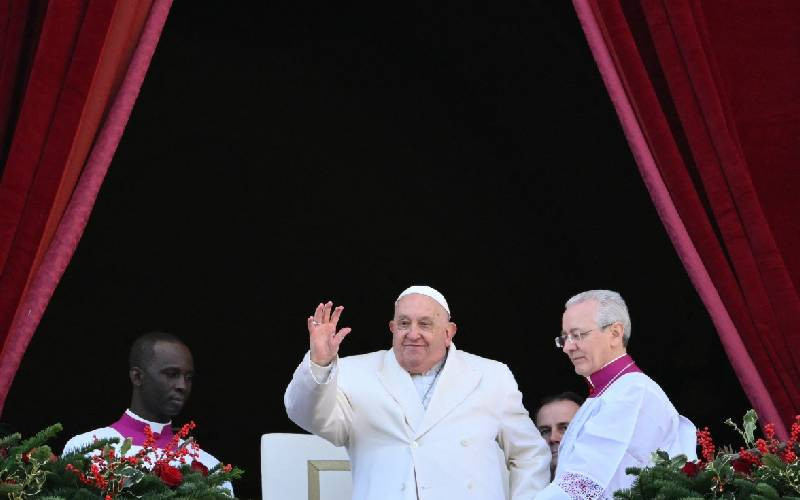 |
|
Kamau Kaniaru, a resident of Embakasi Village, points at raw sewage flowing from the Coca Cola bottling plant in the area. [PHOTO: Jonah Onyango/STANDARD] |
By DANN OKOTH
Embakasi, Kenya: Thousands of Embakasi residents have been putting up with filth for three years despite loud cries for help.
But there now seems to be hope of rescue after the Nairobi City Water and Sewerage Company (NCWSC) finally signalled its intent to repair a burst sewer line.
After inquiries by The Standard, NCWSC placed a newspaper advertisement two weeks ago inviting tenders for the repair of the Coca Cola Company sewage line in Embakasi and asked interested bidders to visit the site last Friday.
“We have invited tenders for the project and expect work to begin soon,” said Mbaruku Vyakweli, Corporate Affairs Manager at NCWSC.
“We know the problem involving the Coca Cola sewerage line has persisted for a while but it will be fixed quite soon now that we have put out this advert,” he added.
Affected areas
Areas worst affected by the sewage flow include Simba Villas Estate in Embakasi, the adjacent Embakasi Garrison and surrounding villages — with the old Embakasi Road having been virtually obliterated by the sewage flow.
“The problem has persisted for three years now,” complained Kamau Kaniaru, who is a member of the Simba Villa Estate Board.
“Our cries for help have gone unheeded and numerous meetings with the company authorities have borne no fruit,” he said.
He says the filth from the bottling factory consists of water waste, including toilet waste, used oil and all manner of debris.
He said the waste poses health risks for both adults and children.
However, last week, Nairobi Bottlers Limited denied any responsibility saying the company was not in charge of the sewer line.
“The accusations directed at our company have been informed by ignorance of city by-laws and even the Company’s Act,” said Peter Muriuki, Nairobi Bottlers Public Affairs and Communications manager.
“Our jurisdiction starts and ends with our one sewerage treatment plant. And if we so much as touch the water company’s sewerage system, then we are liable for prosecution,” he added.
Stay informed. Subscribe to our newsletter
The community had also blamed Kenya Airways for contributing to the environmental mess by channelling the overflow from the company’s own burst sewerage systems to the community’s residential area.
But according to KQ’s facilities manager, Timothy Lokorito, the company shares its sewerage line with the Embakasi Garrison — which adds a new twist to the saga after the community and the garrison had both lodged a complaint with NCWSC and Nema over alleged pollution from the bottling company.
“We only share a common line with Garrison,” asserted Lokorito.”And when the line was damaged during the construction of the Eastern by-pass, we took to exhausting the sewage, which has been overflowing right in front of our gate since,” he said.
He said they had approached NCWSC to repair the line, adding that the undertaking was that those affected would come up with a new design for the repair of the line.
The National Environment Management Authority (Nema), which is mandated to safeguard and enhance the quality of the environment through coordination, research facilitation and enforcement among other things, was yet to act on the situation.
“We have been aware of the problem for some time and have been engaging stakeholders to find a solution,” said Robert Orina, Chief Enforcement Officer at Nema.
“At the moment, however, I do not know what the situation on the ground is. I have to send a team down there to assess the situation and then get back to you,” he said.
Meanwhile, thousands of Embakasi residents affected by the filth say the buck stops with Nema when it comes to environmental protection.
Indeed Nema, Athi Water Services Board, NCWSC and the Ministry of Health have been engaging the community in ping-pong games over the environmental issue since 2010.
Apart from public meetings where promises of action were bandied about, no concrete action has been taken. But the zeal and determination by the community to have the situation addressed, led by the Simba Villa Board, is demonstrated by the amount of correspondence between them and the various authorities, especially in the last one year.
In one such communication with Athi Water Services Board, which owns the water and sewerage infrastructure in Nairobi, the company callously tells the community to supply its physical development plan and adjacent areas before it could act.
The community also wrote several times to Nema and Dr Kepha Ombacho, the Chief Public Health Officer at the Ministry of Health, complaining about the environmental situation in the area.
Nema said last week that the problem at Coca Cola was caused by poor design in the sewer system, where the manholes were constructed under the main sewer lines causing them to clog whenever it rains.
“The problem is that the design of the manholes and the main sewer lines were not compatible, causing the manholes to clog up whenever it rains and resulting in the overflow,” he said.
When asked what the ministry was doing about the situation, Ombacho said: “The ministry is aware of the problem and has been engaging the local communities and the institutions involved to try to solve it. I would have to find out what the situation on the ground is to give a concrete answer.”
But the residents are concerned that this delay is putting the community’s health at further risk.
 The Standard Group Plc is a
multi-media organization with investments in media platforms spanning newspaper
print operations, television, radio broadcasting, digital and online services. The
Standard Group is recognized as a leading multi-media house in Kenya with a key
influence in matters of national and international interest.
The Standard Group Plc is a
multi-media organization with investments in media platforms spanning newspaper
print operations, television, radio broadcasting, digital and online services. The
Standard Group is recognized as a leading multi-media house in Kenya with a key
influence in matters of national and international interest.
 The Standard Group Plc is a
multi-media organization with investments in media platforms spanning newspaper
print operations, television, radio broadcasting, digital and online services. The
Standard Group is recognized as a leading multi-media house in Kenya with a key
influence in matters of national and international interest.
The Standard Group Plc is a
multi-media organization with investments in media platforms spanning newspaper
print operations, television, radio broadcasting, digital and online services. The
Standard Group is recognized as a leading multi-media house in Kenya with a key
influence in matters of national and international interest.









